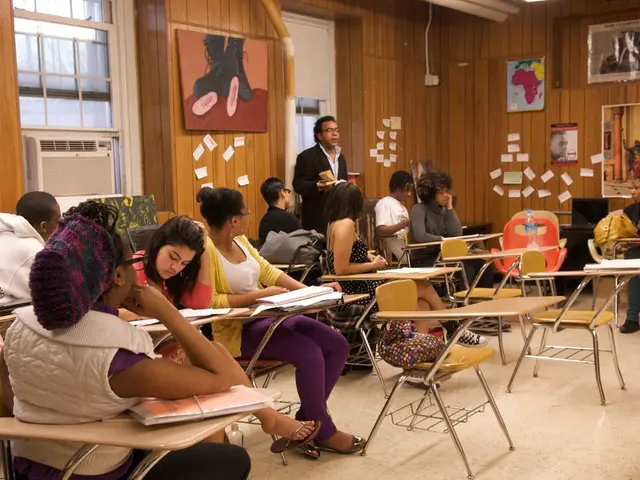Vacation period is over and Summer is encouraging a seamless transition back to school
Preparing Children for a Stress-Free School Year: Practical Tips for Parents
As the first day of school approaches, many children experience anxiety. A study shows that 65% of students feel stressed before September 1st, with primary school students aged 6-9 being the most anxious (78%), followed by high school students at 60%. To help children cope with this anxiety, parents can implement several supportive strategies.
Creating a Calm Environment
One such strategy is creating a cozy "Calm Corner" at home. This space can be filled with favourite books, fidget toys, or calming activities for emotional regulation. By providing a safe and comforting space, children can better manage their anxiety.
Open and Supportive Conversations
Parents should also talk openly and listen to their children without rushing to fix worries. Using open-ended questions to explore their feelings can help children express their anxieties and fears. Encouraging children to share their thoughts and feelings is crucial in building a supportive relationship.
Transitional Comfort Objects
Using transitional objects like a family photo or note in a lunchbox can provide comfort during the day. These objects serve as a reminder of home and offer a sense of security.
Preparing for School Routines
Establishing predictable daily routines and adjusting schedules gradually before school starts also eases the transition. Parents can start adjusting bedtime and wake-up times towards "school hours" to prepare their child's body and mind for the upcoming school year.
Familiarizing with the School Environment
Attending orientation or open house can help children become familiar with teachers, classrooms, and routines. This familiarity can reduce uncertainty and fear, making the first day of school less daunting.
Normalizing Anxiety
Parents should normalize anxiety by acknowledging it is common and sharing their own experiences of nervousness. Offering reassurance without overdoing it can help children feel supported and understood.
Encouraging Coping Strategies
Encouraging coping strategies like deep breathing or journaling can further build resilience. By teaching children effective ways to manage their anxiety, parents can help them navigate the challenges of a new school year.
Maintaining a Healthy Diet
Maintaining a healthy diet is essential to support mood and energy. A balanced diet can help children feel better, both physically and emotionally, making it easier for them to cope with anxiety.
Collaborating with School Staff
Collaborating with school staff for additional accommodations or support if needed can provide extra assistance. By working together, parents and teachers can create a supportive environment that helps children thrive.
Modeling Calm Behavior
Modeling calm behavior is important since children pick up on parental emotions. By remaining calm and composed, parents can help children feel more at ease.
Praising Efforts
Praising efforts when children face anxiety and step out of their comfort zone can boost their confidence. By acknowledging their bravery, parents can encourage children to continue facing their fears.
Making the Wait for School More Enjoyable
Parents can make the wait for school more enjoyable by planning trips, outings, or special activities for the first September weekend. By creating positive experiences, parents can help children associate the start of the school year with happiness and excitement.
Rewarding Efforts in School
Parents should consider planning rewards for their child's efforts in school. This positive reinforcement can motivate children to continue working hard and striving for success.
Lowering Expectations and Focusing on Emotional Closeness
Lowering expectations and focusing on moments of emotional closeness with the child, such as 20 minutes before bed, is beneficial. By creating a safe and loving space, parents can help children feel supported and secure.
Preparing for the School Year
Psychologist Dmitry Pansyuk advises establishing a wake-sleep cycle for children before September 1st, gradually shifting bedtime and wake-up times towards "school hours." Mathematics teacher Olga Grudina recommends reviewing basic rules in Russian and mathematics during the last week or two of August, if the academic year ended normally.
Shifting the Focus to Positive Aspects
The topic of school can be stressful for children, so it's important to shift the focus to positive aspects and share memories. By focusing on the fun and exciting parts of school, parents can help children look forward to the new school year.
Planning Summer Activities
If the summer didn't go as planned, it's important to plan summer activities, involve other family members, simplify tasks, account for unexpected events, and set aside time for oneself. By creating a schedule that works for everyone, parents can ensure a fun and relaxing summer break.
Involving Children in Buying School Supplies
Involving children in buying school supplies can add joy and a sense of control. By giving children a say in their school supplies, parents can help children feel more invested in their education.
Addressing Anxiety
If anxiety severely impacts a child's functioning, professional support may be warranted. By seeking help, parents can ensure that their child receives the support they need to thrive in school.
Every September 1st brings us one step closer to the last school bell. By implementing these practical tips, parents can help their children build confidence, feel supported, and manage anxiety effectively during the school transition.
- To promote a sense of security and emotional regulation, consider creating a cozy "Calm Corner" at home filled with favorite books, fidget toys, or calming activities.
- Actively engage in open and supportive conversations with your children, using open-ended questions to explore their feelings and fears, and encourage them to share their thoughts and emotions.
- Utilize transitional objects such as a family photo or note in a lunchbox to provide comfort during school hours and remind your child of home and the support they have.




